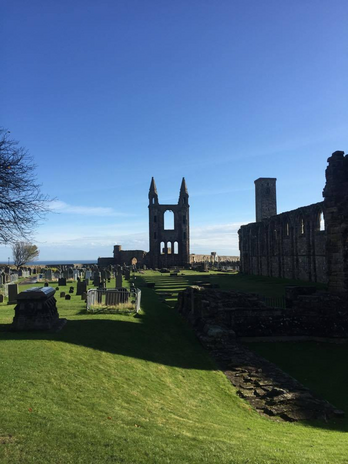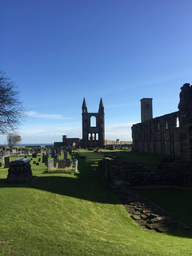At times, the historical majesty of St Andrews gets a little lost in the everyday, sometimes mundane activities with which we fill our time. The fact that we live in a town that was once the ecclesiastical capital of medieval Scotland, where the likes of Edward I and Mary Queen of Scots spent time, is just a small detail that gets muddled in with rushing to class and late night library trips. It’s completely fair to acclimate and lose an aspect of wonder for the place you live in. After almost four years here myself, I’ve gotten used to walking past a 12th-century ruinous cathedral everyday, and rarely stop to think how amazing it is to call that my daily commute. I feel lucky as a medieval history student that I was forced to learn all about the history of St Andrews, and I feel even luckier whenever I remember to use that knowledge to take in the places around me, which is not often enough.
The Layout of Town
A good place to start when thinking about the medieval past of St Andrews is in the basic layout of the town itself. St Andrews as we now conceptualize it was established in 1140, and building possibly started on the site of the castle. Although we think of town now as centering around the three streets, this initial establishment centered around Castle Street and most likely only stretched only as far as North Street. It’s after the building of the cathedral started that the center of town began to shift and a triangle was formed in and out of the town through North Street, to the Cathedral, and down through South Street. To get a sense of what the town looked like before the chaos of the reformation left much of it in ruin, have a look at Geddy’s Map from 1580. You’ll notice details like a building at the end of Market Street, which was actually the site of a prison. The Market Cross near that same site is still marked today, which would have symbolled the beginning of where the seller’s market would’ve taken place. I wondered why Market Street gets a bit wider nearer to the end, but knowing it’s because of the medieval market brings a lot of color into the everyday.
The Cathedral
Arguably the apex of St Andrew’s historical importance, the Cathedral was likely built sometime in the 1160s to accompany St Regulus’ Church (or St Rule’s, hence the name of the pub) on the same site. The building lasted through trials and tribulations such as the Wars of Independence and storms, but was finally completed and dedicated as a cathedral in 1318 in the presence of King Robert the Bruce, a popular symbol of Scottish independence. At the time of its completion, it was the largest church in Scotland and became the headquarters for the Scottish Church. By the 1560s, the cathedral was ransacked during the Reformation, and it was left to fall into ruin. Although there is some sense of its size by walking around the site today, it’s hard to imagine just how amazing this cathedral was in its heyday. I’m a big fan of historical reconstructions and there’s a great video that showcases what the inside would have looked like in 1318. St Regulus’ church is still visible today (it’s the tall tower near the back of the cathedral) but it’s fascinating to imagine how all the ruins stitched together to form such an amazing piece of architecture.
The Castle
To accompany a cathedral, there must be a castle in which the bishops who served the ecclesiastical center can live. Thus, building on the castle started soon after the cathedral in the 1180s. The Wars of Independence saw the castle changing hands multiple times, between the English and the Scottish, until the Scots strategically destroyed it in 1336 to prevent the English from using it. The castle that we see now is in its restored form from around 1400 when it was restored, and it’s quite magical to think that this is the same version of the castle that the likes of James I of Scotland and Bishop Wardlaw (who founded the university) spent time in. Although much of the Great Hall of the castle actually collapsed into the north sea during the Reformation, see if you can make out where the kitchen tower, the square tower, and the underground mine are.
I’ve only chosen the most significant buildings to look at, but there is genuinely so much more to the history of this town. If you’re interested in learning more, there are amazing online resources to explore. Take a visit to the Wardlaw Museum (for free) or there’s even a medieval history module offered all about St Andrews History which I would 100% recommend to not only learn about how significant this town was from the 12th century onwards, but also to gain an appreciation for the town we call home. It’s easy to get caught up in our busy lives sometimes, but taking some time to think about the rich history of St Andrews highlights how incredibly lucky we are to be here.


